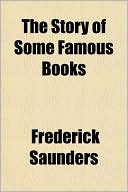

 |

|

The average rating for The Story of Some Famous Books based on 2 reviews is 4 stars.
Review # 1 was written on 2017-01-15 00:00:00 Valium Pi Valium PiSometimes, actually too often, our reading tends to find itself in comfortable places. The images, the metaphors, the references and even the authors become too familiar. We see and then we find and finally we conclude our reading and are satisfied. But what have we missed? What was present in the book that we glossed over, or never even thought about? A reading of Elaine Freegood's The Idea of Things: Fugitive Meaning in the Victorian Novel will reset your reading gyroscope. This book will not only demonstrate how much meaning is still to be found in some of the standards of Victorian Literature, but also create a thirst for a different form and style in your own reading. I am re-reading Great Expectations now. I have read it many times yet I have never thought to even consider the question of what meaning could be contained in the type of tobacco Magwitch uses. How often do we see and dismiss the objects that are presented to us, both in our reading life and, more critically, in our own personal life? This book's strength resides in two places. First, it unpacks with convincing insight and detail the depth of meaning contained in an object that seems innocuous in a novel. Second, it acts as a caution to us as readers to always remain curious and to always question not only what we read but the objects that the authors present us when we read. I have often said that a good novel will be different as I become older and more mature - hopefully I'm still maturing - but now I realize I will always be learning that every object is in itself, a world of "infinite delight" just as William Blake said it would be. |
Review # 2 was written on 2013-12-30 00:00:00 walker mccullough walker mcculloughFreedgood's analysis of things in four significant Victorian novels (Jane Eyre, Mary Barton, Great Expectations, and Middlemarch) provides a type of case study in thing theory and cultural studies. Freedgood identifies objects in the novels that seem to get reference at significant moments, and then she unpacks the cultural significance of those objects in a way that informs themes of the novel. The mahogany furniture in Jane Eyre connects Madeira, Barbados, and England in intricate themes of consumerism, slavery, and mastery. The checked cotton curtains in Mary Barton tell a similar tale about the cotton industry in northern England, India, and the United States. Magwitch's tobacco in Great Expectations evokes culturally embedded ideas of Aboriginal genocide, American slavery, and colonial aggression. Dorothea's "plain dress" in Middlemarch becomes the author's attempt to embed cultural "highbrow" references into the novel as a way to distinguish the work as literature rather than purely fiction. Freedgood's introduction and Coda are exemplary apparatus to delineate her methodology and approach to terms like consumer culture, fetishism, and metonym/metaphor. Apart from serving as an effective model of reading literature with thing theory in mind, Freedgood's book was fairly accessible, direct, and brief (all good things, in my opinion). I even found myself literally laughing aloud at some of her asides and commentary, making this book an enjoyable, informative, and (for my research) invaluable critical study. |
CAN'T FIND WHAT YOU'RE LOOKING FOR? CLICK HERE!!!